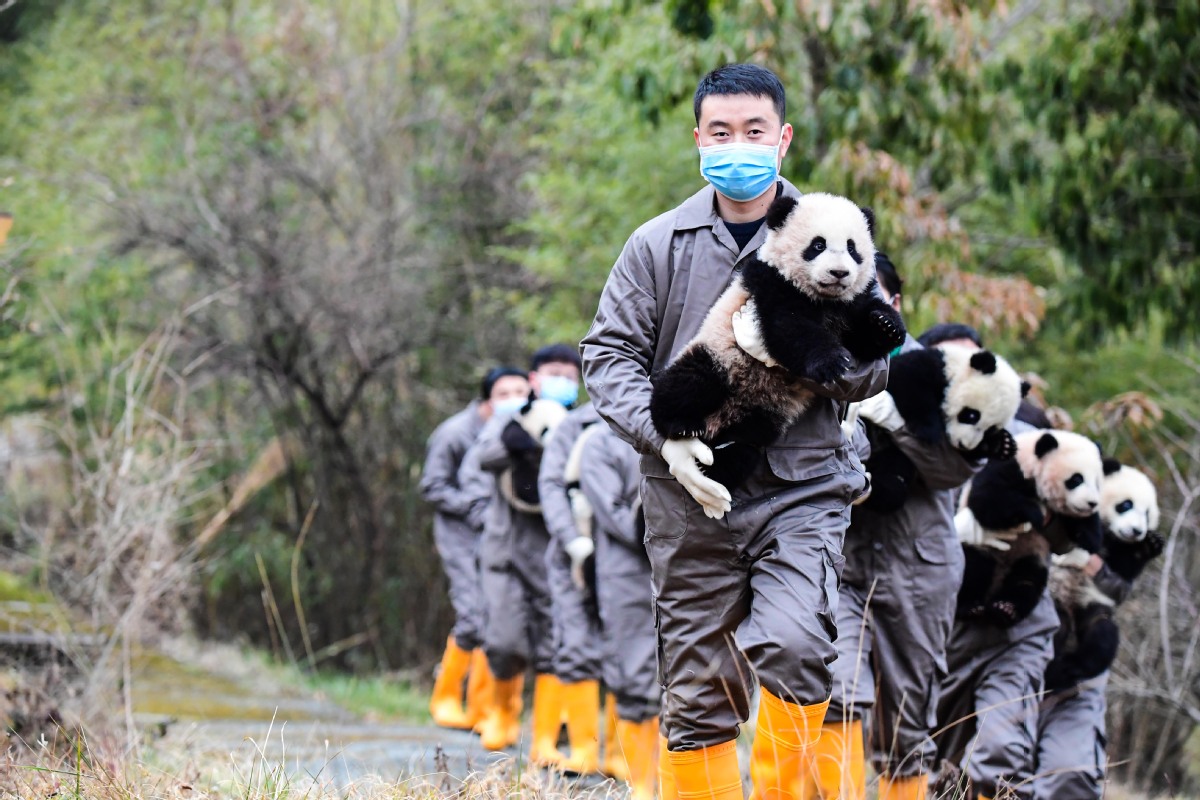Panda cub videos released to ring in Lunar New Year


Keepers hold panda cubs while posing for photos at the Chengdu Research Base of Giant Panda Breeding in Chengdu, Sichuan province, on Friday. To celebrate the upcoming Spring Festival, which falls on Saturday, the base and the China Conservation and Research Center for the Giant Panda jointly held an open house event, during which cubs born in 2023 met the public. Last year, 34 panda cubs were born at the two institutions. [Photo/China Daily]
Two leading panda breeding organizations in Sichuan province jointly issued videos with 24 newborn pandas on Tuesday to celebrate the Lunar New Year, which falls on Saturday.
In the videos, 14 keepers from the China Conservation and Research Center for the Giant Panda and 10 of their counterparts from the Chengdu Research Base of Giant Panda Breeding held pandas born last year, wishing all their viewers well during the Year of the Dragon.
It has been a tradition for both the center and the base to show newborn pandas to visitors on major holidays, said Qiu Yu, an information officer with the center.
Thirty-four pandas were born at the center and base last year, but 10 were not shown in the videos recorded on Sunday, he said.
The global captive panda population stands at 728, with 46 born last year in China and overseas, said Zhang Yue, deputy director of the wildlife conservation department of the National Forestry and Grassland Administration, at a news conference on Jan 25.
China began artificially breeding pandas in the 1960s. At the beginning of this century, it resolved three major panda breeding problems, and the captive population gradually expanded, he said.
It used to be difficult for captive pandas to become ruttish and mate, and for their cubs to survive, said Zhang Hemin, a senior panda expert who started studying the bears in 1983.
At first, researchers did not have a correct understanding of the habits of pandas.
Thinking they preferred a solitary life, researchers kept each panda isolated in a tiny den and only fed them bamboo.
Pandas in a captive environment became depressed and had difficulty becoming ruttish.
Researchers decided to start giving captive pandas more opportunities to socialize.
Male and female pandas were soon placed into each other's dens so that each would become familiar with the scents of the opposite sex.
"We also showed sexually mature pandas videos of their peers having sex, which they could learn in the wild but not in captivity," Zhang said.
Another problem they faced was how to keep pandas active.
Wild pandas generally stay active for hours each day.
To emulate their natural environment, researchers tried putting biscuits rich in vitamins and trace elements in places the pandas could not find easily, aiming to get them to move around.
Many newborn panda cubs used to die because of a quirk bred by nature.
While 50 percent of newborns are twins, a mother typically chooses to care for only one.
In the wild, a mother panda first tries to care for both babies. But several hours later, she realizes she can't. If she tries to support both, both would die. So the mothers desert one of their cubs, even if it cries for her, Zhang said.
Researchers settled on a course that was part philanthropy and part trickery.
They would take away the deserted baby and feed it milk. Then they would switch it with the favored cub from time to time. In this way, the mother unwittingly supported both.
With the three primary obstacles hindering the breeding of captive pandas overcome, a self-sustaining and growing panda population can be developed, Zhang said.








